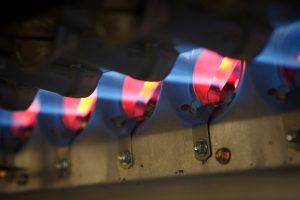 Do you use a gas-powered furnace? If you do, you’re certainly not alone—many homeowners in our area use these powerful and efficient heating systems to keep warm all winter long. But if you are one of these homeowners, there is one potential safety risk you should be aware of—a cracked heat exchanger.
Do you use a gas-powered furnace? If you do, you’re certainly not alone—many homeowners in our area use these powerful and efficient heating systems to keep warm all winter long. But if you are one of these homeowners, there is one potential safety risk you should be aware of—a cracked heat exchanger.
Like any other powerful appliance or equipment that creates combustion gases, an ill-maintained furnace could potentially create health and safety hazards. This is true whether you skip maintenance or delay a necessary repair, especially if that repair is to a cracked heat exchanger! This isn’t a problem that typically occurs in newer heating systems, but rather those that are aging—around 10-15 years old.
The Job of the Heat Exchanger
This component is vital to the functionality of your natural gas furnace. It’s the area where the heat from the combustion gas gets transferred to the air from the blower fan, then moves to the ventilation system. Combustion gasses shouldn’t come in direct contact with the indoor air, otherwise unhealthy fumes will find their way into your living space.
The combustion gas enters the heat exchanger—a metal, clam-shaped camber. The heat from the combustion gases raises the temperature of the metal. As the air from the blower passes around it, heat transfers to the exchanger.
What we are getting at here is that your furnace’s heat exchanger is what makes it possible for a furnace to actually heat your home.
The Danger of a Cracked Heat Exchanger
When there is a crack in a heat exchanger, it allows exhaust fumes to get into the component, and then leak into the indoor air. The most toxic of these fumes is carbon monoxide, which you’ve likely heard referred to as CO. CO can cause severe health problems or even fatality.
When the furnace is in good condition, the system sends the CO fumes out via a flue, but a crack will enable some CO to leak out.
So, what causes this? The most likely culprit is corrosion. The reaction between the metal of your heater and the combustion gas over time causes that metal to weaken. This is why it’s something primarily to watch out for in an older, aging furnace. Even the smallest crack in a heat exchanger can be an issue, since it will open wider as the heat exchanger turns hot and expands.
“How Do I Know If I Have a Cracked Heat Exchanger?”
If you’ve had your furnace maintained this year, your technicians will have checked the status of your heat exchanger. If not, though, it’s important for you to know what signs to watch out for. Rather, you should know what to listen for. If you detect a clicking sound coming from your furnace after the blower shuts off, you might in fact have a cracked heat exchanger.
When it comes down to it, if you suspect any sort of problem with your furnace, no matter how minor it might seem, the best thing you can do is call for professional services. We’ll repair the problem and be able to tell you if the furnace is nearing the time you should consider a replacement.
Established in 1912, Max Sr & Paul Schoenwalder Plumbing, Heating and Air Conditioning, A Corp. is your trusted resource for reliable furnace repair in Chatham, NJ. Reach out to us today.
